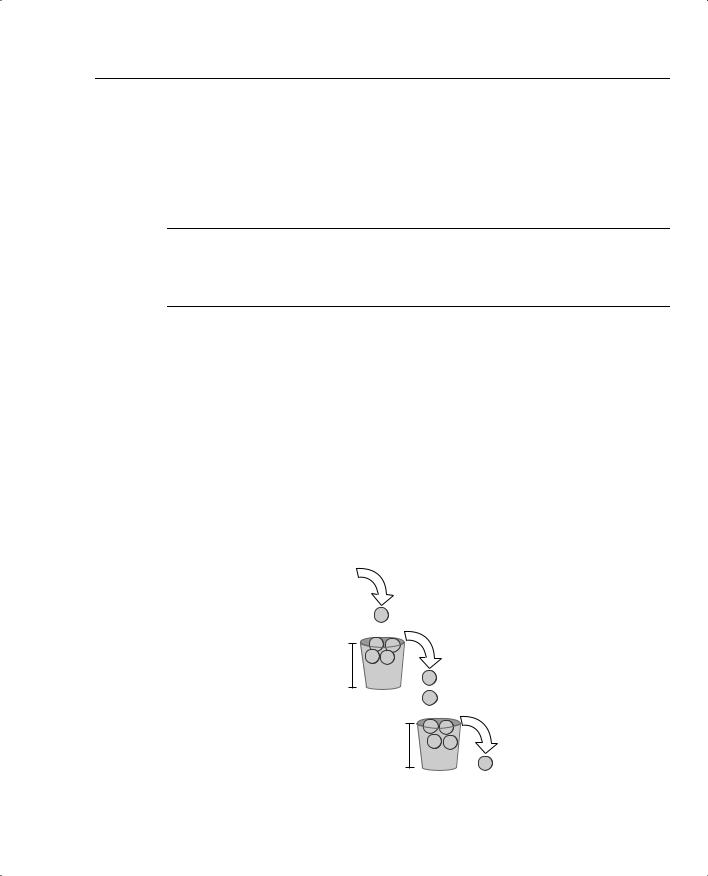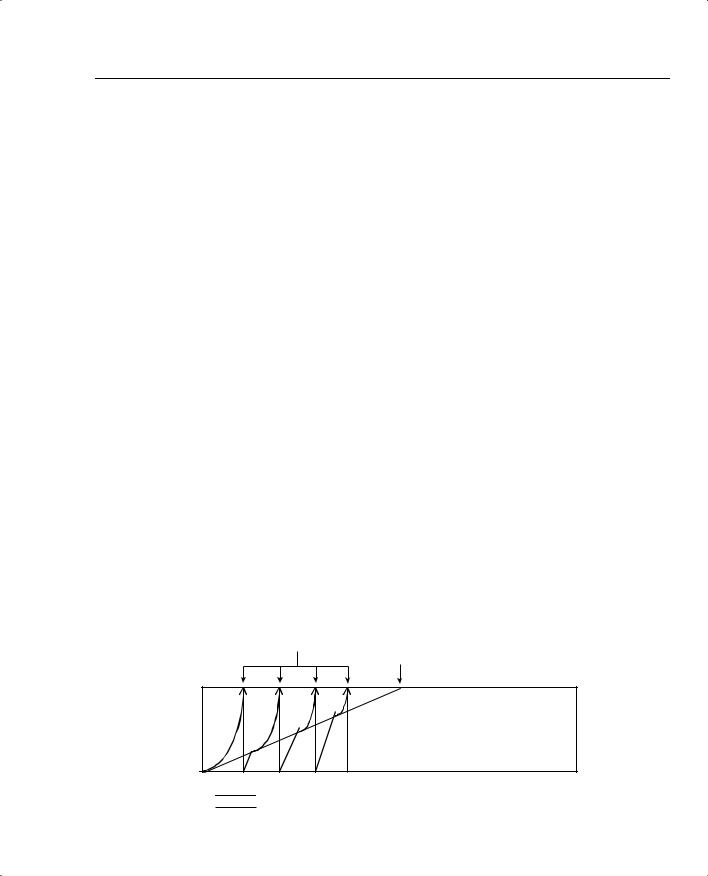
- •QoS Overview
- •“Do I Know This Already?” Quiz
- •QoS: Tuning Bandwidth, Delay, Jitter, and Loss Questions
- •Foundation Topics
- •QoS: Tuning Bandwidth, Delay, Jitter, and Loss
- •Bandwidth
- •The clock rate Command Versus the bandwidth Command
- •QoS Tools That Affect Bandwidth
- •Delay
- •Serialization Delay
- •Propagation Delay
- •Queuing Delay
- •Forwarding Delay
- •Shaping Delay
- •Network Delay
- •Delay Summary
- •QoS Tools That Affect Delay
- •Jitter
- •QoS Tools That Affect Jitter
- •Loss
- •QoS Tools That Affect Loss
- •Summary: QoS Characteristics: Bandwidth, Delay, Jitter, and Loss
- •Voice Basics
- •Voice Bandwidth Considerations
- •Voice Delay Considerations
- •Voice Jitter Considerations
- •Voice Loss Considerations
- •Video Basics
- •Video Bandwidth Considerations
- •Video Delay Considerations
- •Video Jitter Considerations
- •Video Loss Considerations
- •Comparing Voice and Video: Summary
- •IP Data Basics
- •Data Bandwidth Considerations
- •Data Delay Considerations
- •Data Jitter Considerations
- •Data Loss Considerations
- •Comparing Voice, Video, and Data: Summary
- •Foundation Summary
- •QoS Tools and Architectures
- •“Do I Know This Already?” Quiz
- •QoS Tools Questions
- •Differentiated Services Questions
- •Integrated Services Questions
- •Foundation Topics
- •Introduction to IOS QoS Tools
- •Queuing
- •Queuing Tools
- •Shaping and Policing
- •Shaping and Policing Tools
- •Congestion Avoidance
- •Congestion-Avoidance Tools
- •Call Admission Control and RSVP
- •CAC Tools
- •Management Tools
- •Summary
- •The Good-Old Common Sense QoS Model
- •GOCS Flow-Based QoS
- •GOCS Class-Based QoS
- •The Differentiated Services QoS Model
- •DiffServ Per-Hop Behaviors
- •The Class Selector PHB and DSCP Values
- •The Assured Forwarding PHB and DSCP Values
- •The Expedited Forwarding PHB and DSCP Values
- •The Integrated Services QoS Model
- •Foundation Summary
- •“Do I Know This Already?” Quiz Questions
- •CAR, PBR, and CB Marking Questions
- •Foundation Topics
- •Marking
- •IP Header QoS Fields: Precedence and DSCP
- •LAN Class of Service (CoS)
- •Other Marking Fields
- •Summary of Marking Fields
- •Class-Based Marking (CB Marking)
- •Network-Based Application Recognition (NBAR)
- •CB Marking show Commands
- •CB Marking Summary
- •Committed Access Rate (CAR)
- •CAR Marking Summary
- •Policy-Based Routing (PBR)
- •PBR Marking Summary
- •VoIP Dial Peer
- •VoIP Dial-Peer Summary
- •Foundation Summary
- •Congestion Management
- •“Do I Know This Already?” Quiz
- •Queuing Concepts Questions
- •WFQ and IP RTP Priority Questions
- •CBWFQ and LLQ Questions
- •Comparing Queuing Options Questions
- •Foundation Topics
- •Queuing Concepts
- •Output Queues, TX Rings, and TX Queues
- •Queuing on Interfaces Versus Subinterfaces and Virtual Circuits (VCs)
- •Summary of Queuing Concepts
- •Queuing Tools
- •FIFO Queuing
- •Priority Queuing
- •Custom Queuing
- •Weighted Fair Queuing (WFQ)
- •WFQ Scheduler: The Net Effect
- •WFQ Scheduling: The Process
- •WFQ Drop Policy, Number of Queues, and Queue Lengths
- •WFQ Summary
- •Class-Based WFQ (CBWFQ)
- •CBWFQ Summary
- •Low Latency Queuing (LLQ)
- •LLQ with More Than One Priority Queue
- •IP RTP Priority
- •Summary of Queuing Tool Features
- •Foundation Summary
- •Conceptual Questions
- •Priority Queuing and Custom Queuing
- •CBWFQ, LLQ, IP RTP Priority
- •Comparing Queuing Tool Options
- •“Do I Know This Already?” Quiz
- •Shaping and Policing Concepts Questions
- •Policing with CAR and CB Policer Questions
- •Shaping with FRTS, GTS, DTS, and CB Shaping
- •Foundation Topics
- •When and Where to Use Shaping and Policing
- •How Shaping Works
- •Where to Shape: Interfaces, Subinterfaces, and VCs
- •How Policing Works
- •CAR Internals
- •CB Policing Internals
- •Policing, but Not Discarding
- •Foundation Summary
- •Shaping and Policing Concepts
- •“Do I Know This Already?” Quiz
- •Congestion-Avoidance Concepts and RED Questions
- •WRED Questions
- •FRED Questions
- •Foundation Topics
- •TCP and UDP Reactions to Packet Loss
- •Tail Drop, Global Synchronization, and TCP Starvation
- •Random Early Detection (RED)
- •Weighted RED (WRED)
- •How WRED Weights Packets
- •WRED and Queuing
- •WRED Summary
- •Flow-Based WRED (FRED)
- •Foundation Summary
- •Congestion-Avoidance Concepts and Random Early Detection (RED)
- •Weighted RED (WRED)
- •Flow-Based WRED (FRED)
- •“Do I Know This Already?” Quiz
- •Compression Questions
- •Link Fragmentation and Interleave Questions
- •Foundation Topics
- •Payload and Header Compression
- •Payload Compression
- •Header Compression
- •Link Fragmentation and Interleaving
- •Multilink PPP LFI
- •Maximum Serialization Delay and Optimum Fragment Sizes
- •Frame Relay LFI Using FRF.12
- •Choosing Fragment Sizes for Frame Relay
- •Fragmentation with More Than One VC on a Single Access Link
- •FRF.11-C and FRF.12 Comparison
- •Foundation Summary
- •Compression Tools
- •LFI Tools
- •“Do I Know This Already?” Quiz
- •Foundation Topics
- •Call Admission Control Overview
- •Call Rerouting Alternatives
- •Bandwidth Engineering
- •CAC Mechanisms
- •CAC Mechanism Evaluation Criteria
- •Local Voice CAC
- •Physical DS0 Limitation
- •Max-Connections
- •Voice over Frame Relay—Voice Bandwidth
- •Trunk Conditioning
- •Local Voice Busyout
- •Measurement-Based Voice CAC
- •Service Assurance Agents
- •SAA Probes Versus Pings
- •SAA Service
- •Calculated Planning Impairment Factor
- •Advanced Voice Busyout
- •PSTN Fallback
- •SAA Probes Used for PSTN Fallback
- •IP Destination Caching
- •SAA Probe Format
- •PSTN Fallback Scalability
- •PSTN Fallback Summary
- •Resource-Based CAC
- •Resource Availability Indication
- •Gateway Calculation of Resources
- •RAI in Service Provider Networks
- •RAI in Enterprise Networks
- •RAI Operation
- •RAI Platform Support
- •Cisco CallManager Resource-Based CAC
- •Location-Based CAC Operation
- •Locations and Regions
- •Calculation of Resources
- •Automatic Alternate Routing
- •Location-Based CAC Summary
- •Gatekeeper Zone Bandwidth
- •Gatekeeper Zone Bandwidth Operation
- •Single-Zone Topology
- •Multizone Topology
- •Zone-per-Gateway Design
- •Gatekeeper in CallManager Networks
- •Zone Bandwidth Calculation
- •Gatekeeper Zone Bandwidth Summary
- •Integrated Services / Resource Reservation Protocol
- •RSVP Levels of Service
- •RSVP Operation
- •RSVP/H.323 Synchronization
- •Bandwidth per Codec
- •Subnet Bandwidth Management
- •Monitoring and Troubleshooting RSVP
- •RSVP CAC Summary
- •Foundation Summary
- •Call Admission Control Concepts
- •Local-Based CAC
- •Measurement-Based CAC
- •Resources-Based CAC
- •“Do I Know This Already?” Quiz
- •QoS Management Tools Questions
- •QoS Design Questions
- •Foundation Topics
- •QoS Management Tools
- •QoS Device Manager
- •QoS Policy Manager
- •Service Assurance Agent
- •Internetwork Performance Monitor
- •Service Management Solution
- •QoS Management Tool Summary
- •QoS Design for the Cisco QoS Exams
- •Four-Step QoS Design Process
- •Step 1: Determine Customer Priorities/QoS Policy
- •Step 2: Characterize the Network
- •Step 3: Implement the Policy
- •Step 4: Monitor the Network
- •QoS Design Guidelines for Voice and Video
- •Voice and Video: Bandwidth, Delay, Jitter, and Loss Requirements
- •Voice and Video QoS Design Recommendations
- •Foundation Summary
- •QoS Management
- •QoS Design
- •“Do I Know This Already?” Quiz
- •Foundation Topics
- •The Need for QoS on the LAN
- •Layer 2 Queues
- •Drop Thresholds
- •Trust Boundries
- •Cisco Catalyst Switch QoS Features
- •Catalyst 6500 QoS Features
- •Supervisor and Switching Engine
- •Policy Feature Card
- •Ethernet Interfaces
- •QoS Flow on the Catalyst 6500
- •Ingress Queue Scheduling
- •Layer 2 Switching Engine QoS Frame Flow
- •Layer 3 Switching Engine QoS Packet Flow
- •Egress Queue Scheduling
- •Catalyst 6500 QoS Summary
- •Cisco Catalyst 4500/4000 QoS Features
- •Supervisor Engine I and II
- •Supervisor Engine III and IV
- •Cisco Catalyst 3550 QoS Features
- •Cisco Catalyst 3524 QoS Features
- •CoS-to-Egress Queue Mapping for the Catalyst OS Switch
- •Layer-2-to-Layer 3 Mapping
- •Connecting a Catalyst OS Switch to WAN Segments
- •Displaying QoS Settings for the Catalyst OS Switch
- •Enabling QoS for the Catalyst IOS Switch
- •Enabling Priority Queuing for the Catalyst IOS Switch
- •CoS-to-Egress Queue Mapping for the Catalyst IOS Switch
- •Layer 2-to-Layer 3 Mapping
- •Connecting a Catalyst IOS Switch to Distribution Switches or WAN Segments
- •Displaying QoS Settings for the Catalyst IOS Switch
- •Foundation Summary
- •LAN QoS Concepts
- •Catalyst 6500 Series of Switches
- •Catalyst 4500/4000 Series of Switches
- •Catalyst 3550/3524 Series of Switches
- •QoS: Tuning Bandwidth, Delay, Jitter, and Loss
- •QoS Tools
- •Differentiated Services
- •Integrated Services
- •CAR, PBR, and CB Marking
- •Queuing Concepts
- •WFQ and IP RTP Priority
- •CBWFQ and LLQ
- •Comparing Queuing Options
- •Conceptual Questions
- •Priority Queuing and Custom Queuing
- •CBWFQ, LLQ, IP RTP Priority
- •Comparing Queuing Tool Options
- •Shaping and Policing Concepts
- •Policing with CAR and CB Policer
- •Shaping with FRTS, GTS, DTS, and CB Shaping
- •Shaping and Policing Concepts
- •Congestion-Avoidance Concepts and RED
- •WRED
- •FRED
- •Congestion-Avoidance Concepts and Random Early Detection (RED)
- •Weighted RED (WRED)
- •Flow-Based WRED (FRED)
- •Compression
- •Link Fragmentation and Interleave
- •Compression Tools
- •LFI Tools
- •Call Admission Control Concepts
- •Local-Based CAC
- •Measurement-Based CAC
- •Resources-Based CAC
- •QoS Management Tools
- •QoS Design
- •QoS Management
- •QoS Design
- •LAN QoS Concepts
- •Catalyst 6500 Series of Switches
- •Catalyst 4500/4000 Series of Switches
- •Catalyst 3550/3524 Series of Switches
- •Foundation Topics
- •QPPB Route Marking: Step 1
- •QPPB Per-Packet Marking: Step 2
- •QPPB: The Hidden Details
- •QPPB Summary
- •Flow-Based dWFQ
- •ToS-Based dWFQ
- •Distributed QoS Group–Based WFQ
- •Summary: dWFQ Options

Traffic-Policing and Traffic-Shaping Concepts 343
Finally, in this particular example, congestion can occur at the physical interface. The total of the two shaping rates listed in Figure 5-13 is 160 kbps, which exceeds the access rate. Because interface output queues can fill, it helps to apply a queuing tool to the interface output queues in this case.
How Policing Works
The internal processing logic used by IOS when implementing CAR differs slightly from the logic used when implementing class-based (CB) policing. Regardless of the internal processes, each policing tool wants to classify a packet relative to whether it is within the traffic contract. Based on that classification, the packet can be allowed to pass, be dropped, or be re-marked with a different IP precedence or IP DSCP (differentiated services code point) value.
Single and dual token-bucket models are used so that you fully appreciate the internal processing of the policers. Remember, the token-bucket mechanism is used to describe the concepts, but not necessarily to describe how the software is actually written. When no Be is configured, a single bucket is used, which represents Bc, and when Be is used, a second bucket is used, representing Be.
CAR internals are covered in the following sections, followed by CB policing concepts.
CAR Internals
Details aside, what CAR does is decide whether the packet conforms to or exceeds a traffic contract. CAR then takes action on the packet based on the configuration, which tells CAR whether to pass, discard, or re-mark conforming packets and exceeding packets. The actions themselves are simple and obvious; the hard part about CAR is understanding how CAR decides whether a packet conforms to the contract, or exceeds the contract.
CAR uses one or two token buckets to determine whether each packet conforms to or exceeds a traffic contract. CAR fills the buckets with tokens, with each token representing the right to send or receive 1 byte. When a packet is policed, CAR checks the buckets to decide whether enough tokens are in the right bucket to consider the packet as conforming. (The details of how CAR makes that decision are covered in the next few pages.) To understand CAR, you need to understand how CAR fills the buckets with tokens, and how CAR decides, based on the packet and the tokens in the buckets, whether the packet conforms or exceeds the traffic contract.
CAR and CB policing work slightly differently with and without a Be specified. The following sections explain how CAR works without Be, and how it works with Be.
CAR Without Be
Just like most descriptions of policing logic, this book uses token buckets to describe CAR logic. In this discussion, one bucket is called Bucket1, and the other is ingeniously called

344 Chapter 5: Traffic Policing and Shaping
Bucket2. Bucket1 begins with Bc worth of tokens in it, and Bucket2 begins with Be worth of tokens in it. Of course, only Bucket1 is used when Be = 0, but both Bucket1 and Bucket2 are used when Be is greater than 0. In some explanations found in other documents, you might hear Bucket1 referred to as the Bc bucket, or just as Bc. Because Bc is a static, configured value, and the number of tokens in the buckets change, however, I refer to the buckets as Bucket1 and Bucket2.
First, CAR fills Bucket1 with Bc tokens. Remember, each token represents a single byte, and Bc is configured in bytes. As time passes, CAR replenishes Bucket1 at regular intervals, using a Tc value calculated with the same formula used by shaping. The configuration sets the policing rate and the Bc value, with CAR calculating the Tc value based on the following familiar formula:
Bc
Tc = ---------------------------
Policed rate
CAR replenishes Bucket1 every Tc by adding Bc tokens to the bucket. Because Bucket1 has a maximum capacity of Bc tokens, and CAR replenishes Bc tokens every Tc, CAR effectively completely refills Bucket1 every Tc.
CAR categorizes each packet as “conforming” or “exceeding” the traffic contract as it arrives at the policer. CAR compares the number of bytes in the packet to the number of tokens in Bucket1. (Remember, Be = 0 for now, so the policer does not even think about Bucket2 in this case.) CAR’s decision is simple:
•If the number of bytes in the packet is less than or equal to (<=) the number of tokens in Bucket1, the packet conforms. CAR removes tokens from Bucket1 equal to the number of bytes in the packet, and performs the action for packets that conform to the contract.
•If the number of bytes in the packet is greater than (>) the number of tokens in Bucket1, the packet exceeds. CAR does not remove tokens from Bucket1, and performs the action for packets that exceed the contract.
So, without a Be configured, CAR logic is pretty easy. All the packets policed in a single Tc interval conform, so long as the packets cumulative number of bytes does not exceed Bc. If more than Bc bytes need to be sent, CAR decides those packets exceed the contract.
Car with Be
The previous discussion revolved around the simpler case, in which there was no Be. With a Be configured, CAR uses a slightly more complex algorithm to decide whether a packet conforms to or exceeds the traffic contract. This more complex algorithm has a simple goal—to soften the blow when the policer must discard packets. CAR’s algorithm recognizes when the extra bytes defined by Be are being consumed, and classifies some packets as “exceed,” and some packets

Traffic-Policing and Traffic-Shaping Concepts 345
as “conform,” before all of Be has been consumed! The strategy behind discarding a few packets, but not all, when consuming the tokens in Bucket2 follows the same concept as WRED. By discarding a few packets before all the Be capacity has been consumed, maybe the senders of the traffic may reduce the rate of sending packets, reducing congestion, and avoiding the day when all packets exceed the policed rate.
NOTE For the remaining discussion of how policing works with Be, assume that the action for conforming packets is to forward the packet, and the action for nonconforming packets is to discard the packet. Other options, such as re-marking the packets, are available; however, continually referring to those options during this discussion just confuses the discussion.)
To understand how CAR works is to understand how the buckets are filled and drained. Initially, CAR fills Bucket1 with Bc tokens, and Bucket2 with Be tokens. Remember, each token represents a single byte, and Bc and Be are configured in bytes.
CAR replenishes Bucket1 every Tc by adding Bc tokens to the bucket, but CAR does not directly replenish Bucket2. When CAR adds Bc tokens to Bucket1, if any tokens are spilled, those tokens fill Bucket2. If Bc = 10,000, and Bucket1 has 2000 tokens in it when CAR refills Bucket1, for example, 2000 tokens spill into Bucket2. Bucket1 has a maximum capacity of Bc tokens, which effectively means that Bucket1 gets refilled to its maximum every Tc. Bucket2 has a maximum capacity of Be tokens, but it may not get filled to capacity each Tc—that depends on how many tokens “spill” out of Bucket1 when it is refilled. Figure 5-14 outlines the process.
Figure 5-14 Refilling Dual Token Buckets with CAR
Token Generator:
Policer Creates New Tokens,
Refills with Bc Tokens Every Tc
$.25 Token
Spillage Falls
$.25 $.25 into Bucket2
Token Token
$.25 $.25 Bucket1 Token Token
Size:Bc
$.25
Token
$.25 Token
Spillage
$.25 $.25 Wasted
Token Token
Bucket2 |
$.25 |
$.25 |
Size:Be |
Token |
Token |
|
|
$.25 Token

346 Chapter 5: Traffic Policing and Shaping
With Bc and Be configured, CAR uses dual token buckets, and the CAR algorithm gets more complicated. The algorithm is easy and familiar:
1If the number of bytes in the packet is less than or equal to (<=) the number of tokens in Bucket1, the packet conforms. CAR also removes tokens from Bucket1 equal to the number of bytes in the packet and performs the action for packets that conform to the contract.
2If the number of bytes in the packet is greater than (>) the number of tokens in Bucket1, CAR uses the debt calculations to determine whether the packet conforms or exceeds. CAR removes tokens from Bucket2 equal to the number of bytes in the packet if the packet conforms based on this rule.
As noted in part two of the algorithm, CAR uses the concept of debt. This means that if the packet size of a new packet is more than the number of tokens in Bucket1, CAR can borrow from Bucket2. CAR needs to replenish, or repay, those tokens after an interval when Bc is not completely used, as was described earlier.
The term “actual debt” (Da) defines the most obvious concept related to debt calculations. Imagine that Bucket1 has been depleted down to 0 tokens, and Bucket2 has 10,000 tokens in it. A new 1000-byte packet arrives that needs to be policed. CAR compares the packet length to Bucket1, and decides that Bucket1 does not have enough tokens. CAR then looks at Bucket2, which does have more tokens (10,000) than the packet size (1000). Therefore, CAR considers the packet as conforming, and it decrements Bucket2 to 9000. CAR also now considers Da to be 1000—the number of actual tokens “borrowed” from Be or Bucket2. Imagine 2 more 1000byte packets arrive before CAR replenishes tokens into Bucket1. These packets also conform, and CAR decrements Bucket2 down to 8000 tokens after the second packet, and then to 7000 tokens after the third packet. Similarly, Da is incremented to 2000, and then 3000.
Dc is the other key component of the CAR algorithm. The compounded debt (Dc) variable is also calculated by CAR as Be is being consumed. Each time Da is incremented, Dc is also incremented. Dc grows more quickly than Da, however, because the formula used to calculate Dc is Dc = old_Dc + new_Da. Table 5-6 lists the same three packets described in the explanation of Da, plus 2 more 1000-byte packets, with the computed Da and Dc values. In this case, Be is set to 8000 bytes. Keep in mind that the Dc calculation does not begin until Bc (Bucket1) has been consumed during a particular interval.
Table 5-6 Example Comparing Growth in Da and Dc with Five Consecutive 1000-Byte Packets
|
Da = Old Da + |
Dc = Old_Dc + |
|
Packet |
New_Packet_Length |
New_Da |
Dc |
|
|
|
|
1st 1000-byte packet |
1000 |
0 + 1000 |
1000 |
|
|
|
|
2nd 1000-byte packet |
2000 |
1000 + 2000 |
3000 |
|
|
|
|
3rd 1000-byte packet |
3000 |
3000 + 3000 |
6000 |
|
|
|
|
4th 1000-byte packet |
4000 |
4000 + 6000 |
0* |
|
|
|
|
5th 1000-byte packet |
5000 |
0 + 5000 |
5000 |
|
|
|
|
*Dc would have been 10,000, but because Be is 8000 in this example, the Dc value is reset to 0.

Traffic-Policing and Traffic-Shaping Concepts 347
Dc grows until it passes Be. When Dc is calculated and happens to be above Be, CAR considers the packet to exceed the traffic contract. At that point, CAR resets Dc to 0, as shown in Table 5-6. Note that the fourth 1000-byte packet causes the Dc value to exceed Be, so the packet is considered to exceed the contract, and the Dc value is reduced to 0.
Now that Da and Dc have been defined, the full logic of deciding whether each packet conforms or exceeds can be outlined, as shown here:
1If the number of bytes in the packet is less than or equal to (<=) the number of tokens in Bucket1, the packet conforms. CAR removes tokens from Bucket1 equal to the number of bytes in the packet, and performs the action for packets that conform to the contract.
2If the number of bytes in the packet is greater than (>) the number of tokens in Bucket1, but the number of bytes in the packet is less than or equal to (<=) the number of tokens in Bucket2, use the following debt computations:
a.If Dc is less than or equal to (<=) Be, the packet conforms to the contract. CAR removes tokens from Bucket2 equal to the number of bytes in the packet, and performs the action for packets that conform to the contract.
b.If Dc is greater than (>) Be, the packet exceeds the contract. CAR removes no tokens from either bucket, and performs the action for packets that exceed the contract. CAR also resets Dc to 0.
3If the number of bytes in the packet is greater than (>) the number of tokens in Bucket1 or Bucket2, the packet exceeds the contract. CAR removes no tokens from either bucket, and performs the action for packets that exceed the contract.
During a particular interval, as long as there are plenty of tokens in Bucket1, the packets conform (Step 1). If there are not enough tokens in Bucket1 or Bucket2, the packet exceeds (Step 3). At Step 2, however, while consuming Bucket2’s tokens, a few packets can actually exceed the contract, and others will actually conform to the contract. Figure 5-15 depicts the idea behind how Da and Dc grow with CAR.
Figure 5-15 Actual Debt and Compounded Debt with CAR
Point at Which Dc Caused Single
Packet Drop When Dc > Be Point at Which Be Has Been
Consumed; All Packets Dropped
Be
Dc |
Da |
|
0
Dc
Da
